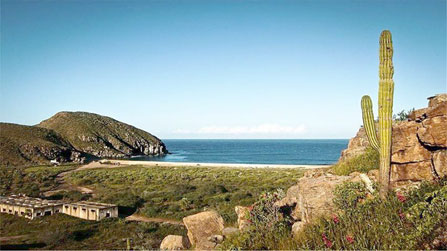Todos Santos, at risk of losing its magic

Todos Santos: sign the petition to protect this landscape (Photo: Salvemos Punta Lobos).
TODOS SANTOS
With scarcely 2,013 households and 5,148 inhabitants, according to the National Institute of Statistics and Geography, this “magical town”, so designated by the Secretary of Tourism, could become a living hell for its current residents if a planned mega-development is approved. The project is slated to provide more than 11,000 rooms integrated into 4,470 living units for a projected population of more than 60,000, not including the seasonal influx.
The project known as the Playa Santos Integrated Tourism Development, Todo Santos, B.C.S. was registered on May 24, 2013 with the Environment and Natural Resources Secretariat (Semarnat) under Special Environmental Impact Statement (EIS) 03BS2013TD030. The EIS received favorable recommendation on Dec. 16, 2013.
According to the EIS, the plan calls for: the construction of three hotels, commercial zones and infrastructure such as roadways, accesses and parking; hydraulic drainage; an electrical network; a desalinization plant and water treatment plant; green areas with native plants; and protection for the zone’s only wetlands.
An investment of US$476.2 million would be made in an area of a little more than 988 acres.
The four project partners are: FRBC Todos Santos, S. de R.L de C.V.; FRBC Todos Santos 2, S. de R.L de C.V.; HSBC México, S.A.; and Inmobiliaria Punta Lobos, S.A. de CV.
When residents learned of the project they roundly rejected it. Their actions convinced the federal government to hold a public consultation on July 29. In attendance was the project’s representative, Carlos Asali Harfuch, who presented information that differed from that contained in the EIS, which was conditional on a series of modifications.
Besides being rejected by the neighbors, the project was deemed by the National Biodiversity Commission to “environmentally unacceptable” because it “presented little information on the effect that the discharge of brine from the desalinization plant could have on the nearby environment. Additionally, there was no analysis that considered the effects on the marine organisms or effects from a regional perspective,” local news sources reported.
For its part, the National Commission on Protected Natural Areas (Conanp) pointed out that the project should adhere to the specifications of the regulation NOM-162-SEMARNAT-2012, for the protection, recuperation, and management of populations of marine turtles in their nesting zone, given that this endangered species occurs within the project’s planned area.
Agustín Bravo Gaxiola, spokesperson for The Mexican Environmental Law, listed a series of anomalies that would need to be fixed in order to make the project viable, among them: the project must be evaluated in a regional context rather than in isolation; and insufficient data is presented for the water plan, which should correctly estimate the use and consumption of water by inhabitants of the development.
Additionally, he points out that the EIS should guarantee a respect for the uses and customs of the Punta Lobos fishermen, above all regarding their access to the beach, since the project is considering the construction of locked gatehouses. From the experiences of other projects, fishermen have ended up being blocked from their traditional access to the coast.
